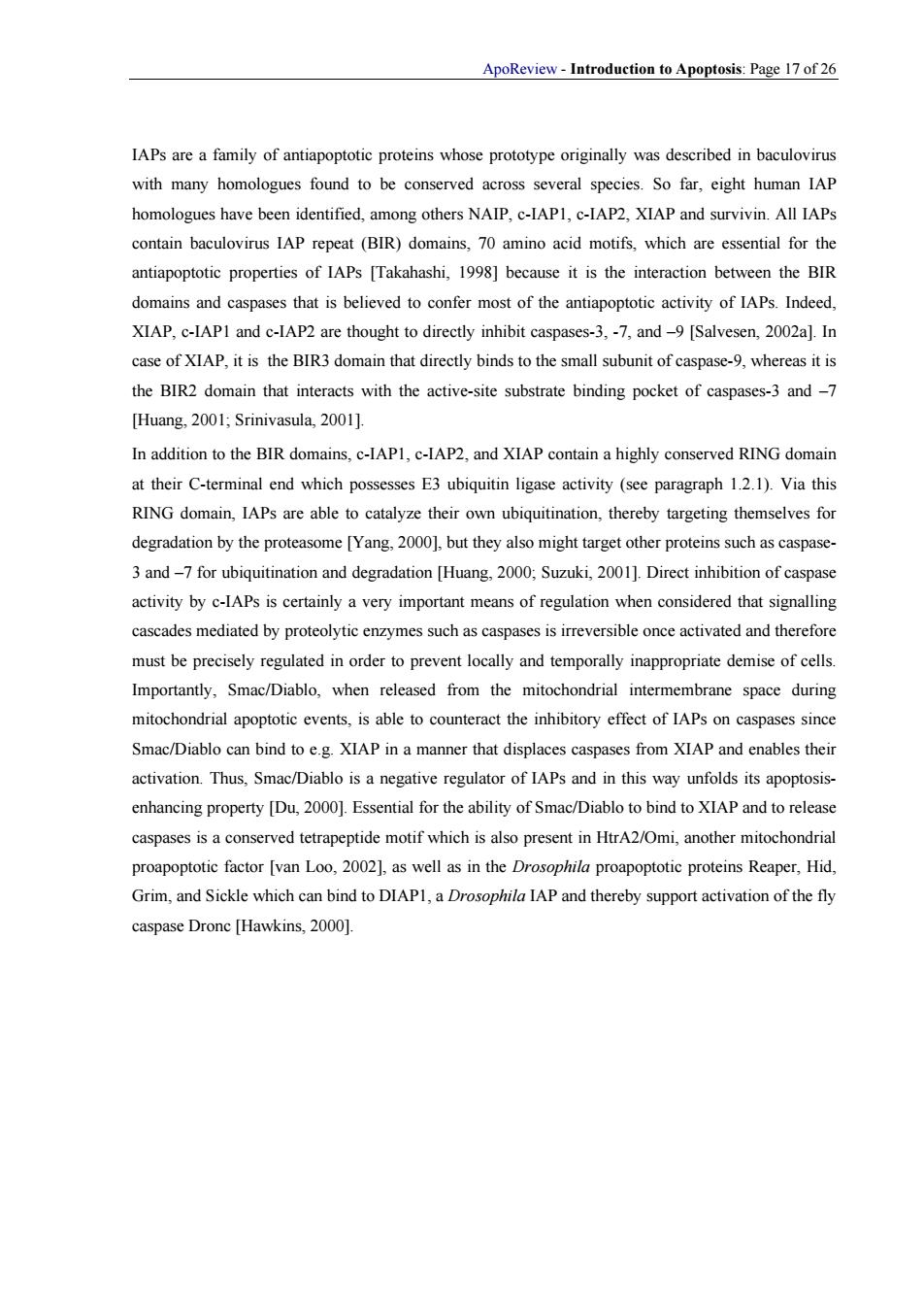正在加载图片...

ApoReview-Introduction to Apoptosis:Page 17of 26 IAPs are a family of antiapoptotic proteins whose prototype originally was described in baculovirus with many homologues found to be conserved across several species.So far,eight human IAP homologues have been identified,among others NAIP,c-IAP1,-IAP2.XIAP and survivin.All IAPs contain baculovirus IAP repeat (BIR)domains.70 amino acid motifs.which are essential for the antiapoptotic properties of IAPs [Takahashi,199]because it is the interaction between the BIR domains and caspases that is believed to confer most of the antiapoptotic activity of IAPs.Indeed. XIAP.c-IAP1 and c-IAP2 are thought to directly inhibit caspases-3.-7.and-9 [Salvesen.2002al.In case of XIAP,it is the BIR3 domain that directly binds to the small subunit of caspase-9.whereas it is the BIR2 domain that interacts with the active-site substrate binding pocket of caspases-3 and-7 [Huang,2001;Srinivasula,2001]. In addition to the BIR domains,c-IAP1,c-IAP2,and XIAP contain a highly conserved RING domain at their C-terminal end which possesses E3 ubiquitin ligase activity (see paragraph 1.2.1).Via this RING domain,IAPs are able to catalyze their own ubiquitination,thereby targeting themselves for degradation by the proteasome [Yang,2000]but they also might target other proteins such as caspase- 3and-7for ubiquitination and degradation [Huang000 Suzuki,1].Direct inhibition of caspase activity by c-IAPs is certainly a very important means of regulation when considered that signalling cascades mediated by proteolytic enzymes such as caspases is irreversible once activated and therefore must be precisely regulated in order to prevent locally and temporally inappropriate demise of cells Importantly,Smac/Diablo,when released from the mitochondrial intermembrane space during mitochondrial apoptotic events,is able to counteract the inhibitory effect of IAPs on caspases since Smac/Diablo can bind to e.g XIAP in a manner that displaces caspases from XIAP and enables their activation.Thus,Smac/Diablo is a negative regulator of IAPs and in this way unfolds its apoptosis- enhancing property [Du,2000].Essential for the ability of Smac/Diablo to bind to XIAP and to release caspases is a conserved tetrapeptide motif which is aso present in,another mitochondrial proapoptotic factor [van Loo,2002]as well as in the Drosophila proapoptotic proteins Reaper.Hid. Grim,and Sickle which can bind to DIAPI,a Drosophila IAP and thereby support activation of the fly caspase Drone [Hawkins,2000].ApoReview - Introduction to Apoptosis: Page 17 of 26 IAPs are a family of antiapoptotic proteins whose prototype originally was described in baculovirus with many homologues found to be conserved across several species. So far, eight human IAP homologues have been identified, among others NAIP, c-IAP1, c-IAP2, XIAP and survivin. All IAPs contain baculovirus IAP repeat (BIR) domains, 70 amino acid motifs, which are essential for the antiapoptotic properties of IAPs [Takahashi, 1998] because it is the interaction between the BIR domains and caspases that is believed to confer most of the antiapoptotic activity of IAPs. Indeed, XIAP, c-IAP1 and c-IAP2 are thought to directly inhibit caspases-3, -7, and –9 [Salvesen, 2002a]. In case of XIAP, it is the BIR3 domain that directly binds to the small subunit of caspase-9, whereas it is the BIR2 domain that interacts with the active-site substrate binding pocket of caspases-3 and –7 [Huang, 2001; Srinivasula, 2001]. In addition to the BIR domains, c-IAP1, c-IAP2, and XIAP contain a highly conserved RING domain at their C-terminal end which possesses E3 ubiquitin ligase activity (see paragraph 1.2.1). Via this RING domain, IAPs are able to catalyze their own ubiquitination, thereby targeting themselves for degradation by the proteasome [Yang, 2000], but they also might target other proteins such as caspase- 3 and –7 for ubiquitination and degradation [Huang, 2000; Suzuki, 2001]. Direct inhibition of caspase activity by c-IAPs is certainly a very important means of regulation when considered that signalling cascades mediated by proteolytic enzymes such as caspases is irreversible once activated and therefore must be precisely regulated in order to prevent locally and temporally inappropriate demise of cells. Importantly, Smac/Diablo, when released from the mitochondrial intermembrane space during mitochondrial apoptotic events, is able to counteract the inhibitory effect of IAPs on caspases since Smac/Diablo can bind to e.g. XIAP in a manner that displaces caspases from XIAP and enables their activation. Thus, Smac/Diablo is a negative regulator of IAPs and in this way unfolds its apoptosisenhancing property [Du, 2000]. Essential for the ability of Smac/Diablo to bind to XIAP and to release caspases is a conserved tetrapeptide motif which is also present in HtrA2/Omi, another mitochondrial proapoptotic factor [van Loo, 2002], as well as in the Drosophila proapoptotic proteins Reaper, Hid, Grim, and Sickle which can bind to DIAP1, a Drosophila IAP and thereby support activation of the fly caspase Dronc [Hawkins, 2000]